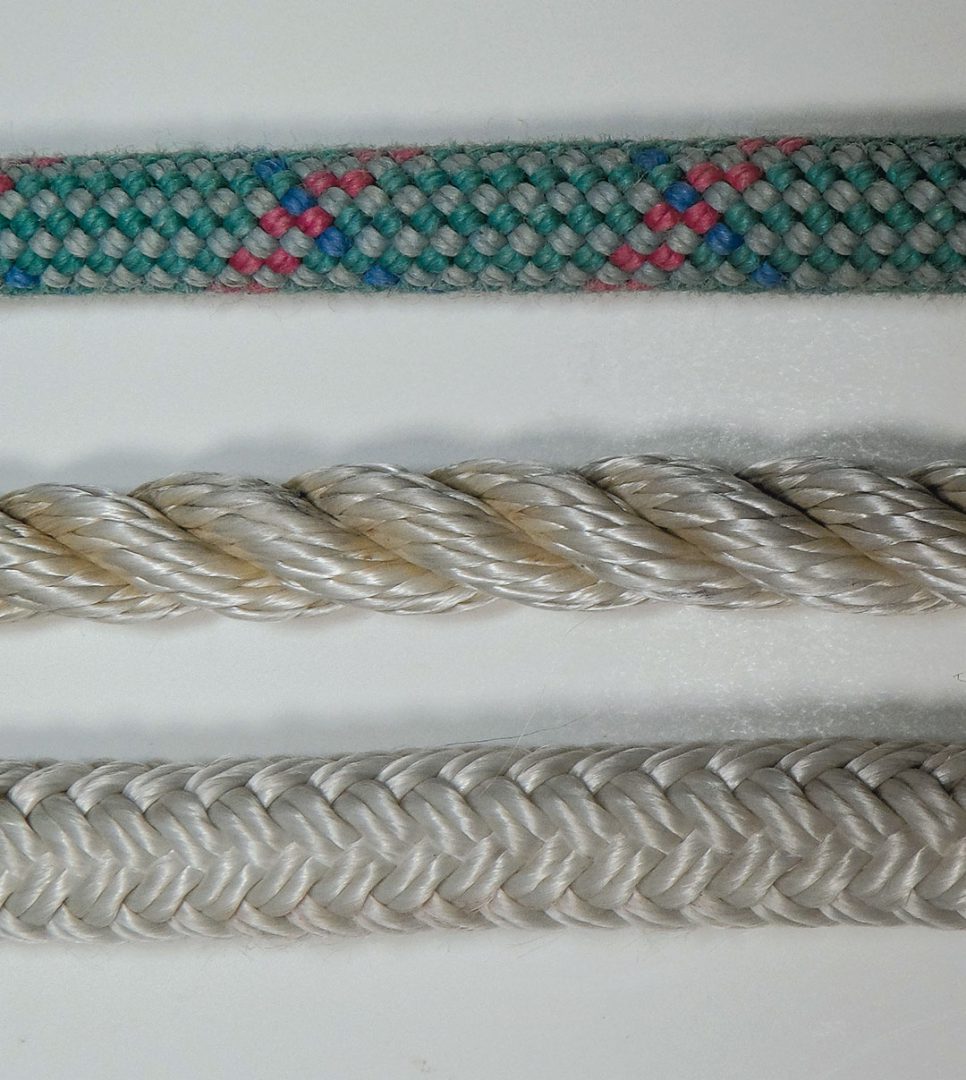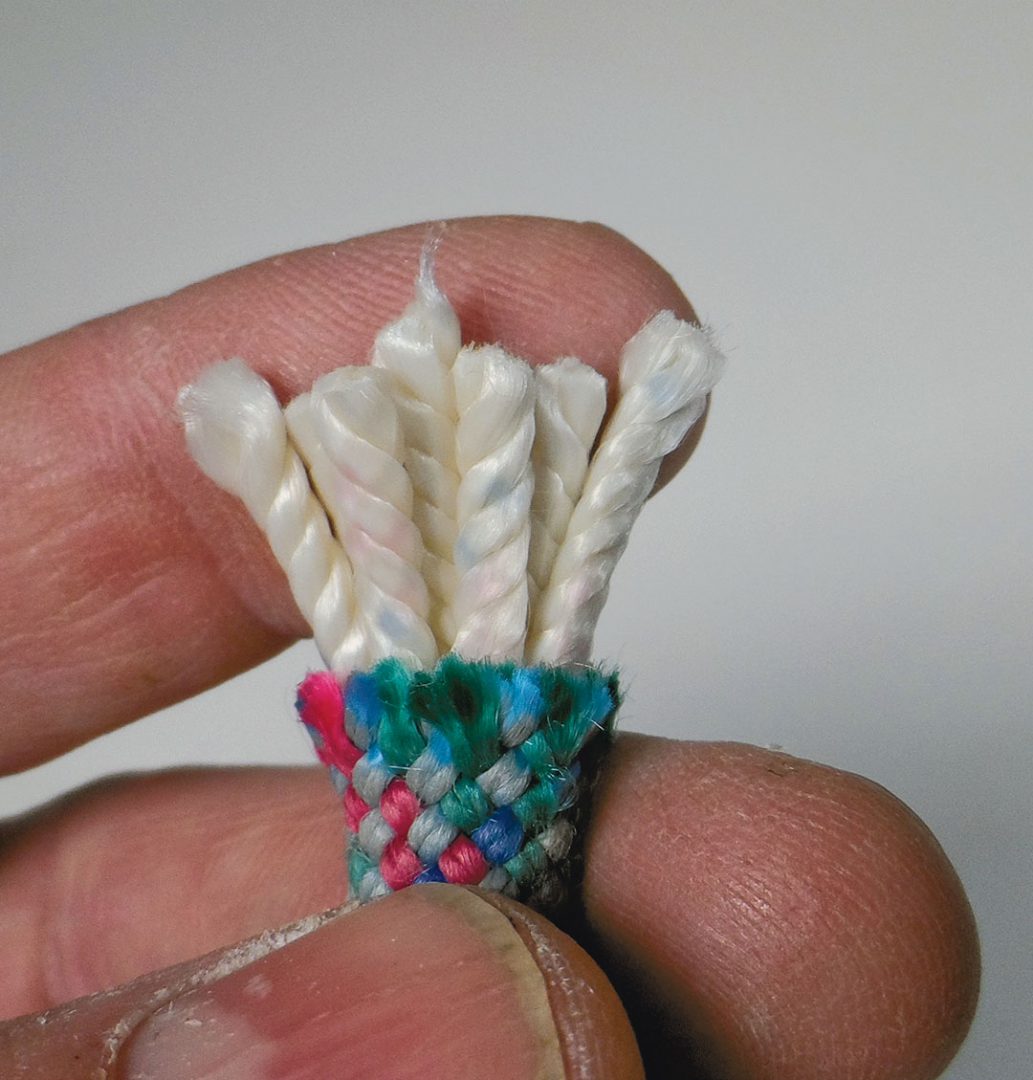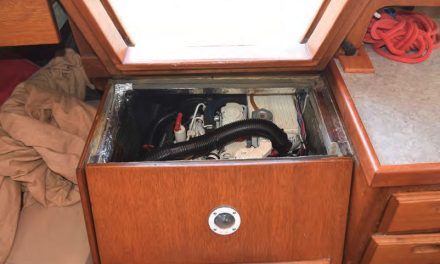Dynamic climbing rope can be an intriguing option for some uses aboard.
Issue 135: Nov/Dec 2020

Top to bottom: UIAA climbing rope, three-strand, and double-braid.
I’m a sailor, and I’m a climber. For both pursuits, rope is central. Not surprisingly, because the use cases for rope aboard a boat and on a mountain are so different, the ropes themselves are fundamentally different. No climber would consider using a marine rope on the mountain, but this sailor has used climbing rope aboard for decades, to his advantage. You may want to do the same.
What Climbing Rope Is Not
To start, dynamic climbing rope (not to be confused with static climbing rope) is stretchy, made of nylon, and designed to absorb the energy of falling climbers. For this reason, the only appropriate place aboard for climbing rope is where stretch in rope is a good thing. (I wouldn’t use climbing rope for a halyard or sheet, for instance—nor any place where a polyester or Dyneema rope would be used to minimize stretch.) In other words, aboard a boat, dynamic climbing rope is a potential replacement only for nylon marine ropes. But the common material used to make both dynamic climbing rope and nylon marine rope is where the similarities end between the two. Understanding the differences (they’re all about the weave) between nylon ropes is key to understanding why, for some uses, I use climbing rope aboard.
Let’s start on the outside and work our way in.
The Cover
The cover on climbing rope (which climbers call the mantle) is woven far more tightly than on any nylon double-braid made for boats. The tighter cover weave prevents individual fibers from snagging on rough surfaces and thus greatly increases abrasion resistance. In fact, climbing rope is about as chafe resistant as polyester double-braid, an obvious benefit of the tight cover, since ordinarily, polyester is significantly more abrasion resistant than nylon. Unfortunately, the tighter cover weave makes climbing rope nearly impossible to splice because the weave is hard to open, and so it’s nearly impossible to bury a tail.
Typically, 28 to 35 percent of the material in climbing rope is found in the cover (the balance is in the core). This is in sharp contrast to marine nylon double-braid, where the cover comprises 50 percent of the rope’s material. Why does it matter that climbing rope has more core material in comparison, when comparing equivalent diameters? Because a rope’s core absorbs impact.

Climbing rope’s core is neither braided nor laid, but rather consists of an even number of parallel twisted yarns that are free to float around; this heightens its ability to remain strong even within knots and over sharp edges.
The Core
Compared to the braided core of marine nylon double-braid, the core of dynamic climbing rope consists of free-floating yarns. A benefit of a core of free-floating yarns is that the core strands can better equalize strain around a tight-radius bend. This is because each strand functions separately and “floats” within the core as required to accommodate the forces at work. The result is less loss of strength where knots are tied and a reduced tendency for a rope to sever if loaded over an edge.
Another aspect of these free-floating yarns is that half are twisted in the conventional direction (s-twist) and half in the opposite direction (z-twist). This makes dynamic climbing rope non-
rotational under load. (A dramatic example of rope that is rotational under load is nylon three-strand rope. If a climber, for example, were to hang from three-strand rope, the lay would straighten slightly and the climber would spin, which is disconcerting and inconvenient when hanging from the side of a mountain.)
Additionally, the free-floating core of dynamic climbing rope reduces internal wear (chafe between fibers), resulting in a fatigue life three to five times longer than nylon double-braid or even three-strand.
Quality
Any of the known brands of marine double-braid you’ll find at your local chandler are proven and up to the tasks aboard. But climbing rope is a step above in terms of quality. It’s among the highest-quality rope produced—manufactured and tested to internationally recognized standards so that it can carry the International Climbing and Mountaineering Federation (UIAA) symbol. In fact, only climbing ropes can pass the UIAA drop test. All other weaves and rope types of comparable size (including comparable marine ropes) fail in fewer than the minimum number of test cycles. Logically, there is no market for anything less because a climber’s life very literally hangs by a thread (and hopefully more than one).
Interestingly, the nylon base material used to make climbing rope is no different than that used to make good-quality nylon marine rope, and therein lies a lesson: it’s all about the weave and the attributes the weave imparts.
We are all accustomed to considering the weaves of the ropes we use aboard. Nylon rope for marine use is typically woven as three-strand, double-braid, plait, and tubular webbing (granted, tubular webbing is not rope, but it clearly illustrates the difference a weave makes). Now, consider that climbing rope is yet another weave. However, unlike the other weaves, dynamic climbing rope is manufactured only in a limited size range, from 6 to 11 millimeters (roughly 1/4-inch to 7/16-inch), so size is sometimes a limiting factor in the use cases aboard, especially for larger boats. Let’s compare (nylon-to-nylon) the weaves more directly.
Double-Braid
Characteristics
- Good flexibility
- Fair knotting
- Medium grip
- Medium splicing difficulty
- Medium to poor chafe resistance
- Less stretch
- Poor fatigue resistance
Use Cases
- Light-duty docklines: a good choice.
- Smaller anchor rode: a good choice.
- Traveler control lines: good aboard larger boats, where climbing rope is too small.
Plaited Rope
Characteristics
- Best flexibility
- Good knotting
- Better grip
- Easy to splice
- Poor chafe resistance
- More stretch
- Better fatigue resistance
Use Cases
- Very large docklines: perhaps the only appropriate use, provides ease of handling, ease of storage, and high stretch—but prone to picking up splinters from bull rails and wooden docks.
- Anchor rode: favored by some, perhaps only because they’ve not considered chafe test results.
Three-Strand
Characteristics
- Less flexibility
- Better grip
- Poor knotting
- Easy to splice
- Good chafe resistance
- More stretch
- Better fatigue resistance
Use Cases
- Anchor rode: the top choice.
- Docklines (in locations where chafe is a factor or when splicing is desired): the top choice.
- Anchor snubbers: good for bridles, but rotation under load can be a problem for single-line snubbers.
Dynamic Climbing Rope
Characteristics
- Good flexibility
- Best knotting
- Less grip
- Not practical to splice
- Very good chafe resistance
- Most stretch
- Best fatigue resistance
Use Cases
- Traveler control lines: a top choice as its superior shock-absorbing characteristics can serve to protect hardware in harsh accidental jibes (though eyes must be sewn, DIY sewn eye splices are acceptable because the load is low—see youtube.com/goodoldboat for my video on sewn eye splices).
A while back, discussing splice strength with the late Brion Toss, I mentioned using climbing rope for traveler control lines. Although he had not tried climbing rope, he said he had been recommending nylon double-braid to cruising sailors to reduce jibe impact loads, and that he had received positive feedback. - Single-line snubbers: a top choice due to its stretch, long fatigue life, chafe resistance, and non-rotation under load characteristics.
- Small boat (<25 feet) rode: a nice hand, excellent shock absorption, and good chafe resistance, but slightly less grip than three-strand and cannot be spliced.
- Secondary/emergency bosun’s chair tether: the best choice; catching a falling human is what DCR is designed for (though I would never use it to hoist or to climb using ascenders).
- Dinghy towing: if chafe resistance is more important to you than floating characteristics, DCR would excel, easing the strain on dinghy eye fitting(s).
Tubular Webbing
Characteristics
- Best flexibility
- Poor grip
- Good knotting
- Cannot splice, but easy to sew
- Best chafe resistance
- Less stretch
- Very good fatigue resistance
- Strongest around small-radius bend
Use Cases
- Chafe guards on docklines and snubbers: a superior and economical choice.
- Clew straps (holding mainsail tack to boom while allowing sliding): an excellent choice (Dyneema webbing is my first choice.)
- Downhaul straps: (Thread from the deck, up through the tack grommet, and back down to a tackle attached to a loop in the free end.) Though no nylon weave is an excellent choice, tubular webbing will do the job (Dyneema webbing would be my first choice for this use case).
We may be a long way from the age of square riggers, but rope continues to be the most vital and indispensable tool on a sailboat. Here it has to stretch, there it has to resist chafe, up there it has to resist stretch, down here it has to absorb shock loading, and back there it has to float. It’s why the ropes we use aboard are made from different materials and constructed differently. But when it comes to nylon in particular, consider dynamic climbing rope as another weave in your arsenal. It’s widely available, no more expensive than quality marine double-braid, and will likely serve you well in targeted applications.

(Left to right) Dynamic climbing rope, nylon, three-strand nylon, plaited or brait nylon, and tubular webbing after a 20-minute chafe test. The samples were slid back and forth 2 inches across a cinder block for 600 cycles, under 100 pounds of tension. The looser the weave, the more the cinder block would pull at fibers and cut them. Tight weaves, on the other hand, wear by fuzzing, lasting much longer. Note that the chafe results might be different on a smoother surface, where snagging is less of a concern. This test was developed to evaluate anchor rodes and docklines.
Relative Rope Stretch
This table shows the relative elongation (stretch) of various ropes when non-shock loaded to 15% of respective breaking strengths. (Note: for a given nominal size, the breaking strengths of the four nylon ropes are roughly equal and vary among manufacturers.)

Climber Rope Resources
Climbers retire ropes early for safety reasons, so used ropes in very good condition are often available. Ropes can be purchased in 40- to 70-meter lengths, or you can buy them by the foot through a few climbing gear suppliers. Be careful not to mistake static climbing rope for dynamic climbing rope. Static climbing rope is stiff and does not absorb impact well; I don’t find it’s a good substitute for polyester marine rope aboard, except perhaps smaller static cord for trampoline lacing aboard a catamaran. Dynamic climbing rope is available in the following sizes: twin (6-7 mm), half (7-8 mm) and single (9-11 mm).
Here are a couple of sources for dynamic climbing rope: mec.ca, backcountrygear.com.
Good Old Boat Technical Editor Drew Frye draws on his training as a chemical engineer and pastimes of climbing and sailing to solve boat problems. He cruises Chesapeake Bay and the mid-Atlantic coast in his Corsair F-24 trimaran, Fast and Furry-ous, using its shoal draft to venture into less-explored waters. He is most recently author of Rigging Modern Anchors (2018, Seaworthy Publications).
Thank you to Sailrite Enterprises, Inc., for providing free access to back issues of Good Old Boat through intellectual property rights. Sailrite.com





